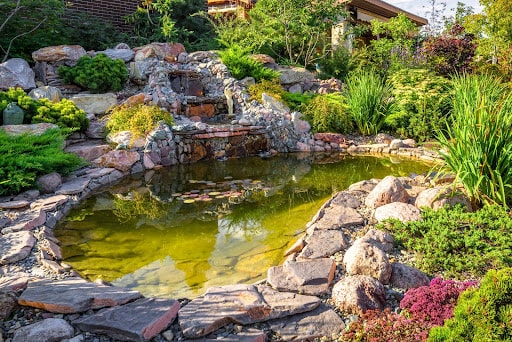Introduction:
Embarking on the journey of building a pond is an exciting endeavor that goes beyond the mere creation of a water feature. Ponds serve as dynamic ecosystems, fostering a harmonious blend of nature and design. Understanding the importance and benefits of ponds is crucial as we delve into the comprehensive process of bringing this aquatic oasis to life.
Ponds, whether large or small, contribute significantly to the aesthetic appeal of any landscape. Beyond their visual allure, they play a pivotal role in supporting biodiversity, providing habitat for various aquatic plants, fish, amphibians, and insects. The calming sound of flowing water, the vibrant colors of aquatic flora, and the serene atmosphere created by a well-designed pond make it a focal point for relaxation and contemplation.
The benefits of building a pond extend beyond the immediate aesthetic and recreational advantages. Ponds can serve practical purposes, such as water conservation and stormwater management. Additionally, they contribute to environmental sustainability by creating microhabitats that attract and support a diverse range of wildlife. As we embark on the journey of building a pond, we will explore not only the technical aspects of construction but also the broader implications of creating a balanced and thriving aquatic ecosystem.
Contents
Planning Your Pond:
The initial phase of building a pond is a crucial step that sets the foundation for a successful and sustainable aquatic ecosystem. Thoughtful planning ensures that the pond seamlessly integrates with its surroundings, enhances the overall landscape, and fulfills its intended purpose. In this section, we will delve into key considerations and decision points that will guide you through the planning process.
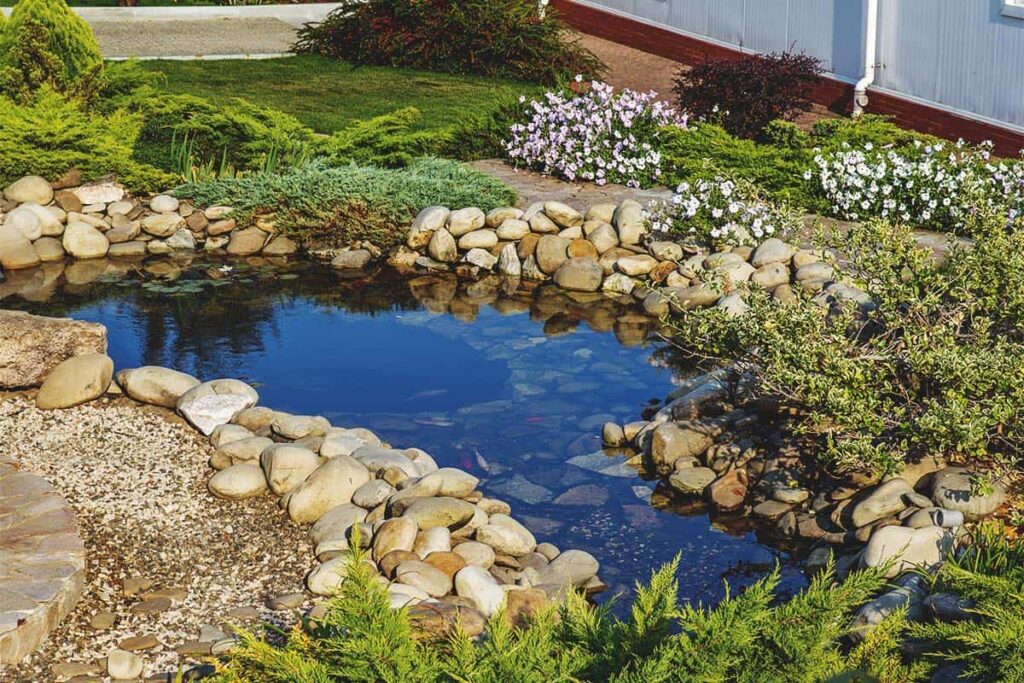
Site Selection:
Selecting the right location for your pond is a pivotal decision that directly influences its overall health and visual impact. Considerations such as sunlight exposure, accessibility, and the natural terrain should be carefully evaluated. Sunlight exposure plays a crucial role in determining the growth of aquatic plants and the overall vitality of the pond ecosystem. Accessibility is essential for construction, maintenance, and enjoyment, while the existing terrain and slope can impact water circulation and the overall aesthetic appeal.
Pond Size and Shape:
The size and shape of your pond are integral components of its design, influencing both aesthetics and functionality. Consider the available space in your landscape, taking into account any constraints or opportunities presented by the surroundings. Whether you opt for a compact decorative pond, an expansive koi pond, or a wildlife habitat, the size and shape should align with your vision and the natural features of the environment.
Purpose of the Pond:
Defining the purpose of your pond is a crucial step that guides subsequent design and construction decisions. Are you creating a serene decorative pond, a vibrant koi habitat, or a wildlife sanctuary? Each purpose comes with specific requirements and considerations, influencing aspects such as water depth, filtration needs, and the selection of aquatic life. Clarifying the intended purpose ensures that your pond fulfills your expectations and contributes meaningfully to the ecosystem.
As we navigate through the planning phase, careful consideration of site-specific factors and a clear understanding of the pond’s purpose will lay the groundwork for a successful and harmonious water feature. By addressing these key aspects, you pave the way for a pond that not only enhances the beauty of your outdoor space but also becomes a thriving and sustainable aquatic haven.
Designing the Pond:
The design phase of building a pond is where creativity and functionality converge to shape the physical aspects of your aquatic haven. From selecting essential components to envisioning water features and integrating landscaping elements, this section will guide you through the intricate process of turning your pond plan into a well-defined design.
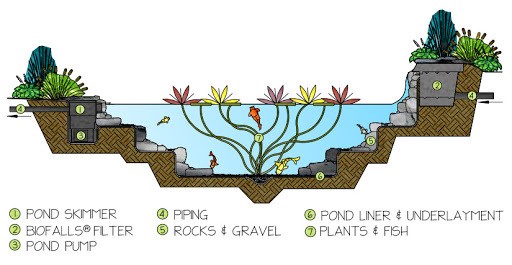
Pond Components:
Selecting the right components is fundamental to the structural integrity and long-term success of your pond. This includes careful consideration of the pond liner, shape, and depth. The choice of liner material is critical for preventing water seepage, and the overall shape and depth of the pond impact its visual appeal and ability to sustain aquatic life. Additionally, installing a reliable filtration system is vital for maintaining water quality by removing impurities and supporting a balanced ecosystem.
Creating Water Features:
Water features add character and dynamism to your pond, turning it into a visually captivating focal point. Whether it’s the gentle flow of a waterfall, the elegance of a fountain, or the serenity of a meandering stream, each water feature contributes to the overall ambiance of the pond. Consider factors such as the water source, pump capacity, and the desired visual and auditory effects when incorporating these features into your pond design.
Incorporating Landscaping:
Landscaping elements play a crucial role in enhancing the natural beauty of your pond and its surroundings. This includes selecting suitable aquatic plants, strategically placing rocks and gravel, and considering the vegetation around the pond. Aquatic plants not only contribute to the aesthetic appeal but also provide essential habitat and contribute to water quality. Thoughtful landscaping ensures a seamless integration of the pond into the broader landscape, creating a cohesive and visually pleasing outdoor environment.
As you delve into the design phase, envisioning the various components and features that will define your pond, attention to detail and a harmonious blend of creativity and functionality will guide you toward creating a water feature that not only meets your aesthetic preferences but also supports a thriving and balanced ecosystem.
Excavation and Construction:
The excavation and construction phase is a hands-on stage where the vision of your pond begins to take shape. From preparing the site to installing structural components, this section will provide a step-by-step guide to the physical implementation of your pond design.
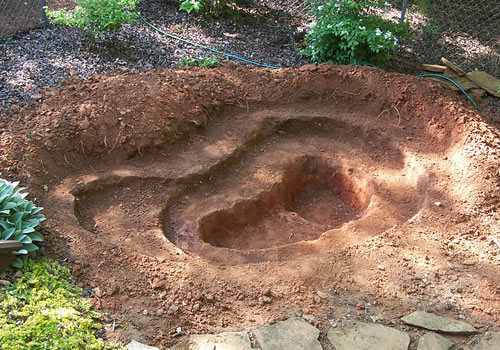
Equipment and Tools:
Before breaking ground, it’s essential to gather the necessary equipment and tools for excavation and construction. This includes excavators for larger projects, shovels for precision work, and wheelbarrows for transporting materials. Having the right tools ensures efficiency and precision throughout the construction process.
Marking and Digging:
Accurate marking and digging are critical to achieving the desired shape and depth of your pond. Follow the guidelines established during the planning and design phases to ensure consistency. Precision in excavation sets the stage for proper liner placement and structural integrity, contributing to the long-term success of your pond.
Installing Pond Liner:
The pond liner is a key element in preventing water seepage and maintaining the water level. Proper positioning and securing of the liner are crucial steps in this process. Ensure that the liner fits the excavated shape, and use appropriate techniques to secure it, creating a watertight seal that will withstand the test of time.
Building Structural Components:
As you progress with construction, attention turns to building structural components such as shelves for plants and the installation of the filtration system. Shelves provide varied depths to accommodate different aquatic plants, while the filtration system is essential for maintaining water quality. Thoughtful construction of these components contributes to the overall health and sustainability of your pond.
Water Quality Management:
Ensuring optimal water quality is a critical aspect of pond ownership, contributing to the health of the aquatic ecosystem and the overall longevity of your pond. This section will guide you through the essential steps of water quality management, from testing parameters to implementing filtration systems and maintaining a balanced environment.
Importance of Water Testing:
Regular water testing is the cornerstone of effective water quality management. Understanding key parameters such as pH levels, ammonia and nitrate concentrations, and oxygen levels allows you to make informed decisions regarding the health of your pond. Monitoring these factors helps prevent imbalances that could negatively impact aquatic life and the overall ecosystem.
Pond Filtration:
A well-designed filtration system is vital for maintaining water clarity and purity. Biological filtration involves beneficial bacteria that break down organic matter, while mechanical filtration physically removes debris. Both components work in tandem to create a balanced and healthy environment. Choosing the right filtration system based on the size and purpose of your pond is essential for long-term success.
Adding Beneficial Bacteria:
Beneficial bacteria play a crucial role in breaking down organic material, preventing the accumulation of harmful substances, and promoting a stable ecosystem. Understanding the role of these microorganisms and implementing proper application methods are key to harnessing their benefits. This natural approach to water quality management contributes to the overall sustainability of your pond.
As you navigate the intricacies of water quality management, a proactive and informed approach will be your guide. Regular testing, appropriate filtration, and the integration of beneficial bacteria ensure that your pond not only remains visually appealing but also provides a healthy and thriving habitat for aquatic life. By mastering these fundamentals, you lay the groundwork for a pond that stands as a testament to responsible stewardship of a dynamic and balanced ecosystem.
Planting and Stocking:
The planting and stocking phase of pond development introduces life and vitality to your aquatic environment. From selecting and placing aquatic plants to introducing fish and wildlife, this section provides a comprehensive guide to creating a balanced and visually appealing ecosystem within your pond.
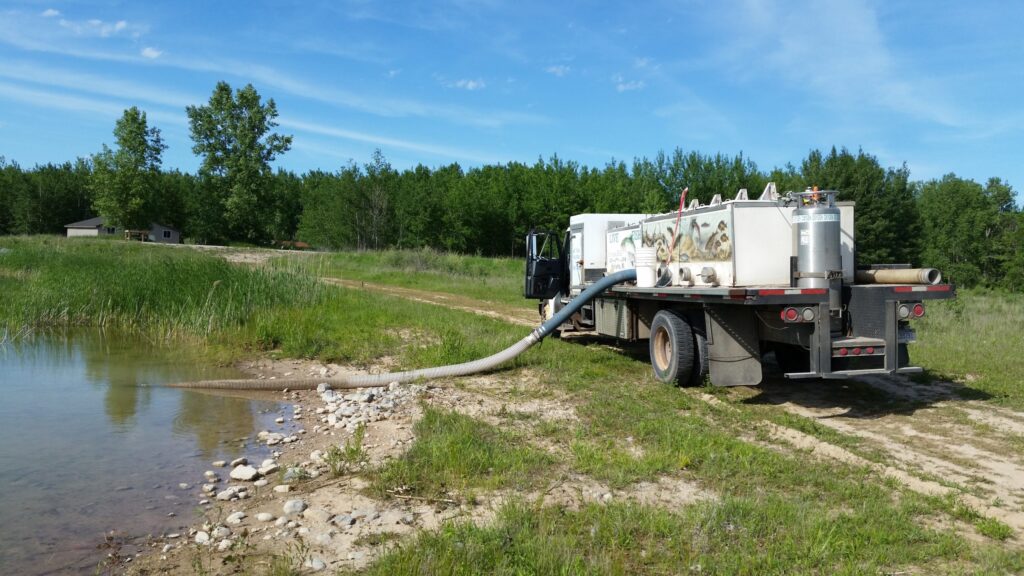
Choosing Aquatic Plants:
Aquatic plants play a multifaceted role in pond ecosystems, contributing to aesthetics, water quality, and habitat. Understanding the categories of submerged, floating, and marginal plants is crucial when selecting vegetation for your pond. Each type serves a specific purpose, from oxygenation to providing shelter for aquatic life. Thoughtful consideration of plant species and placement enhances the overall health and appearance of your pond.
Introducing Fish and Wildlife:
The introduction of fish and wildlife adds another layer of complexity to your pond, transforming it into a dynamic and interactive ecosystem. Whether you opt for the vibrant colors of koi and goldfish, the charming presence of frogs and turtles, or the melodious sounds of visiting birds, each addition contributes to the diversity and vitality of your pond. Consider the compatibility of species, proper acclimatization, and the establishment of a balanced population to ensure the well-being of all inhabitants.
Creating a Balanced Ecosystem:
Achieving a harmonious balance between plants, fish, and other wildlife is essential for the long-term sustainability of your pond. Properly managing stocking densities, understanding the nutrient cycle, and providing adequate habitat contribute to the overall health of the ecosystem. This balance fosters a self-sustaining pond that requires minimal intervention while flourishing as a thriving aquatic habitat.
Maintenance and Care:
Maintaining and caring for your pond is an ongoing responsibility that ensures its continued health, aesthetic appeal, and functionality. This section provides a comprehensive guide to the regular tasks and considerations involved in the upkeep of your pond.
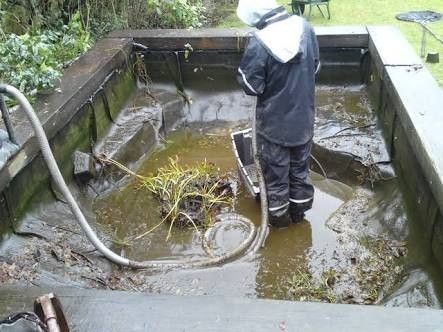
Regular Cleaning:
Routine cleaning is fundamental to the health of your pond. Removing debris such as fallen leaves, twigs, and excess plant material prevents the buildup of organic matter, which can lead to water quality issues. Regular cleaning also includes skimming the water surface and cleaning out the pond bottom to maintain optimal conditions for aquatic life.
Algae Control:
Algae, while natural in ponds, can become problematic if not properly managed. Implementing strategies for algae control, such as the introduction of beneficial aquatic plants, UV clarifiers, or algaecides, helps maintain water clarity and prevents overgrowth. Finding a balance between a natural, ecologically sound approach and targeted interventions ensures a healthy pond environment.
Winterizing Your Pond:
Preparing your pond for the winter months is crucial to protect aquatic life and prevent damage to equipment. This includes measures to safeguard fish, such as providing aeration to prevent freezing, and protecting the pond surface from ice damage. Winterizing also involves adjusting feeding habits and, if necessary, installing a floating de-icer to maintain an opening in the ice.
By incorporating these maintenance practices into your routine, you not only preserve the aesthetic beauty of your pond but also contribute to the longevity of the ecosystem. Regular cleaning, effective algae control, and thoughtful winterization measures collectively ensure that your pond remains a vibrant and sustainable feature in your outdoor landscape.
Troubleshooting Common Issues:
Even with careful planning and regular maintenance, pond owners may encounter various challenges that require prompt attention. This section serves as a guide to identifying, addressing, and resolving common issues that may arise in the life of your pond.
Green Water:
Green water, caused by algae blooms, is a common issue that can affect pond clarity. Understanding the factors contributing to green water, such as excessive nutrients and sunlight exposure, allows for targeted solutions. Implementing natural remedies, adjusting nutrient levels, and incorporating UV clarifiers are effective strategies to restore water clarity.
Fish Health Problems:
Ensuring the well-being of your fish is paramount, and recognizing signs of health issues is crucial for prompt intervention. Common fish health problems may include parasitic infections, bacterial diseases, or environmental stressors. Identifying symptoms, consulting with a vet if necessary, and implementing appropriate treatments are essential steps in maintaining a healthy fish population.
Leaks and Structural Issues:
Detecting and addressing leaks or structural problems promptly is crucial to prevent water loss and potential damage to the pond structure. Regularly inspecting the pond for signs of leaks, such as dropping water levels or wet spots, allows for timely repairs. Structural issues, such as damaged liners or compromised edges, should be addressed promptly to maintain the integrity of the pond.
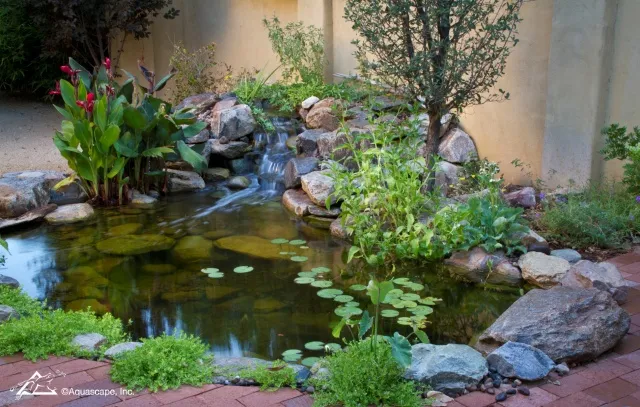
Conclusion:
As you embark on the fulfilling journey of building, maintaining, and enjoying your pond, it’s essential to reflect on the holistic benefits and long-term rewards that this aquatic feature brings to your outdoor space. The conclusion section encapsulates the joy, responsibility, and satisfaction that come with pond ownership.
Enjoying Your Pond:
A pond is more than a static water feature; it’s a dynamic ecosystem that evolves over time. Take the time to relish the serenity it brings to your surroundings, whether it’s the gentle babble of a waterfall, the vibrant colors of aquatic plants, or the graceful movements of fish gliding through the water. Creating moments of contemplation and connection with nature enhances the overall enjoyment of your pond.
Long-Term Benefits:
The decision to build a pond is an investment in the long-term well-being of your outdoor space. Beyond its aesthetic allure, a well-maintained pond contributes to environmental sustainability, supporting biodiversity and creating a microhabitat for various flora and fauna. The balanced ecosystem you’ve cultivated enhances the overall health of your garden and fosters a sense of stewardship for the natural world.
Encouraging Sustainability:
As a pond owner, you play a crucial role in fostering sustainability within your immediate environment. Through responsible practices such as water conservation, natural algae control, and wildlife-friendly landscaping, your pond becomes a model for harmonious coexistence between human-designed spaces and the natural world. By sharing your knowledge and experiences, you contribute to a broader community of environmentally conscious pond enthusiasts.
In conclusion, your pond is a testament to the seamless integration of art, nature, and engineering. It is a source of joy, a haven for wildlife, and a reflection of your commitment to creating a balanced and sustainable outdoor environment. Embrace the ongoing journey of pond ownership with a sense of pride, responsibility, and the knowledge that you are contributing to the beauty and resilience of the natural world.
